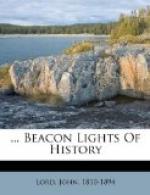The celebrated Lorenzo de’ Medici was then in the height of power and fame in Florence, adored by Roscoe as the patron of artists and poets, although he subverted the liberties of his country. This over-lauded prince, heir of the fortunes of a great family of merchants, wishing to establish a school for sculpture, filled a garden with statues, and freely admitted to it young scholars in art. Michael Angelo was one of the most frequent and enthusiastic visitors to this garden, where in due time he attracted the attention of the magnificent Lord of Florence by a head chiselled so remarkably that he became an inmate of the palace, sat at the table of Lorenzo, and at last was regularly adopted as one of the Prince’s family, with every facility for prosecuting his studies. Before he was eighteen the youth had sculptured the battle of Hercules with the Centaurs, which he would never part with, and which still remains in his family; so well done that he himself, at the age of eighty, regretted that he had not given up his whole life to sculpture.
It was then as a sculptor that Michael Angelo first appears to the historical student,—about the year 1492, when Columbus was crossing the great unknown ocean to realize his belief in a western passage to India. Thus commercial enterprise began with the revival of art, and was destined never to be separated in its alliance with it, since commerce brings wealth, and wealth seeks to ornament the palaces and gardens which it has created or purchased. The sculptor’s art was not born until piety had already edifices in which to worship God, or pride the monuments in which it sought the glories of a name; but it made rapid progress as wealth increased and taste became refined; as the need was felt for ornaments and symbols to adorn naked walls and empty spaces, especially statuary, grouped or single, of men or animals,—a marble history to interpret or reproduce consecrated associations. Churches might do without them; the glass stained in every color of the rainbow, the altar shining with gold and silver and precious stones, the pillars multiplied and diversified, and rich in foliated circles, mullions, mouldings, groins, and bosses, and bearing aloft the arched and ponderous roof,—one scene of dazzling magnificence,—these could do without them; but the palaces and halls and houses of the rich required the image of man,—and of man not emaciated and worn and monstrous, but of man as he appeared to the classical Greeks, in the perfection of form and physical beauty. So the artists who arose with the revival of commerce, with the multiplication of human wants and the study of antiquity, sought to restore the buried statues with the long-neglected literature and laws. It was in sculptured marbles that enthusiasm was most marked. These were found in abundance in various parts of Italy whenever the vast debris of the ancient magnificence was removed, and were universally admired and prized by popes, cardinals, and princes, and formed the nucleus of great museums.




